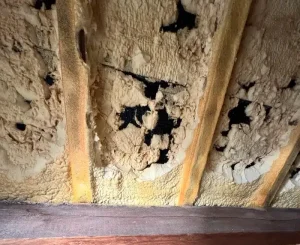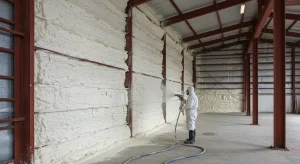Introduction
Spray foam insulation is an advanced solution that enhances energy efficiency, improves indoor comfort, and provides long-term savings on utility bills. Unlike traditional materials such as fiberglass or cellulose, spray foam expands to fill gaps and cracks, creating a highly effective air barrier. This guide explores the benefits of spray foam insulation, its applications, and key considerations for homeowners and businesses.
What Is Spray Foam Insulation?
Spray foam insulation is a polyurethane-based material applied as a liquid that quickly expands into a dense, solid layer. It provides superior insulation by sealing air leaks and preventing moisture intrusion. There are two primary types:
- Open-cell spray foam: A softer, more flexible option with a lower R-value per inch but excellent soundproofing properties.
- Closed-cell spray foam: A denser, more rigid option with a higher R-value per inch and greater resistance to moisture and structural reinforcement.
Energy Efficiency and Cost Savings
Lower Energy Bills
Spray foam insulation significantly reduces energy consumption by minimizing heat loss and air leakage. By forming an airtight seal, it prevents conditioned air from escaping, reducing the workload on HVAC systems.
Long-Term Return on Investment
Although the upfront cost of spray foam insulation is higher than traditional materials, the energy savings quickly offset the initial expense. Homeowners and businesses often recover their investment within a few years through reduced heating and cooling costs.
Improved Indoor Comfort
Consistent Indoor Temperature
Unlike other insulation types, spray foam eliminates drafts and cold spots by sealing gaps in walls, attics, and crawl spaces. This creates a more stable indoor climate, reducing temperature fluctuations.
Soundproofing Benefits
Open-cell spray foam is particularly effective in absorbing sound, making it an excellent choice for reducing noise transmission between rooms or from external sources.
Moisture and Mold Resistance
Prevents Moisture Intrusion
Closed-cell spray foam acts as a moisture barrier, preventing water vapor from penetrating walls and ceilings. This is especially beneficial in humid climates or areas prone to condensation.
Reduces Mold Growth
By limiting moisture buildup, spray foam insulation helps prevent the growth of mold and mildew, contributing to a healthier indoor environment.
Structural Strength and Durability
Reinforces Building Structure
Closed-cell spray foam enhances the structural integrity of walls and roofs, adding rigidity and improving overall durability. This makes it a preferred choice for hurricane-prone or high-wind areas.
Longevity and Minimal Maintenance
Unlike fiberglass or cellulose insulation, spray foam does not sag, compress, or degrade over time. Once applied, it maintains its effectiveness for decades without requiring replacement or frequent maintenance.
Where Can Spray Foam Be Applied?
Attics and Roofs
Spray foam is commonly used in attics to prevent heat loss and regulate indoor temperature. It also protects against moisture infiltration, reducing the risk of roof damage.
Walls and Crawl Spaces
Applying spray foam in walls and crawl spaces ensures an airtight seal, preventing energy loss and moisture accumulation.
Basements and Foundations
Sealing basements with spray foam reduces drafts, prevents water seepage, and improves overall insulation efficiency.
Choosing the Right Insulation Solution
Comparing Spray Foam to Other Insulation Types
| Feature | Spray Foam | Fiberglass | Cellulose |
|---|---|---|---|
| Air Sealing | Excellent | Poor | Moderate |
| Moisture Resistance | High | Low | Moderate |
| Longevity | 20+ Years | 10-15 Years | 10-15 Years |
| Energy Savings | High | Moderate | Moderate |
Finding a Reliable Contractor
Proper installation is crucial for maximizing the benefits of spray foam insulation. Work with experienced professionals to ensure correct application and long-term performance.
A Smart Investment for Energy Efficiency
Spray foam insulation is a powerful solution for improving energy efficiency, indoor comfort, and structural durability. Whether you’re upgrading an existing property or working on new construction, choosing spray foam can lead to significant savings and a healthier living environment.
For expert guidance and professional installation, contact Flatland Roofing & Insulation at (806) 606-6794 or email info@flatlandroofcoatings.com.
Frequently Asked Questions
1. How much does spray foam insulation cost?
The cost depends on factors such as the type of spray foam, project size, and installation complexity. On average, installation ranges from $1.50 to $3 per square foot.
2. Is spray foam insulation safe?
Once cured, spray foam is non-toxic and safe. During installation, proper ventilation is required to minimize exposure to fumes.
3. Can spray foam be applied over existing insulation?
In some cases, spray foam can be applied over old insulation, but it is generally recommended to remove existing material for optimal performance.
4. How long does spray foam insulation last?
Spray foam insulation can last over 20 years without degrading, making it one of the most durable insulation options available.
5. Does spray foam insulation prevent pests?
Spray foam seals entry points, reducing the likelihood of pest infestations. However, it does not contain pesticides or actively repel insects.
6. Is spray foam insulation environmentally friendly?
Spray foam can improve energy efficiency, reducing carbon footprints. Some formulations use eco-friendly blowing agents to minimize environmental impact.
7. Will spray foam insulation affect my HVAC system?
Because it reduces energy loss, spray foam may allow for downsizing HVAC equipment, leading to further energy savings.
8. Can I install spray foam insulation myself?
Professional installation is recommended to ensure proper application, avoid health risks, and achieve maximum efficiency.
9. What is the difference between open-cell and closed-cell spray foam?
Open-cell is softer and provides better soundproofing, while closed-cell is denser, offering higher insulation value and moisture resistance.
10. How quickly can spray foam insulation be installed?
Most residential projects can be completed in one to two days, depending on the scope of work and accessibility of the area.





